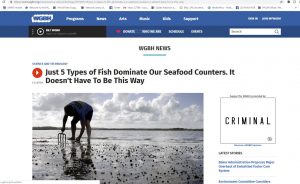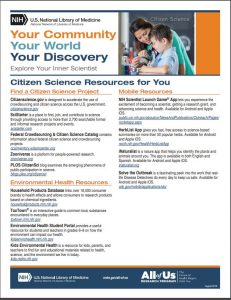Jun
03

Posted by Susan Halpin on June 3rd, 2019
Posted in: Blog, NLM Resources
Tags: Citizen Science, citizen science resources, diversifying New England's Seafood Marketplace, Eat Like a Fish, Eating with the Ecosystem, seafood


What New England foods do you associate with summertime in New England? I bet “Lobstah” and “Fried Clams” are in your top ten answers. Being a “Foodie” who has lived in New England my whole life, I am very in tune with using local ingredients choosing recipes that celebrate New England’s local species and seasonal harvest. So when WGBH (my favorite local NPR station) aired a story with the title, “Just 5 Types of Fish Dominate Our Seafood Counters, It Doesn’t Have to be This Way,” they had me at Hello!
The story was about a citizen science project called “Eat Like a Fish,” that was coordinated by Eating with the Ecosystem, a small nonprofit whose mission is to promote a place-based approach to sustaining New England’s wild seafood, through healthy habitats, flourishing food webs, and short, adaptive supply chains (https://www.eatingwiththeecosystem.org/).
This citizen science project was a bit different than a typical citizen science project that studies wildlife in their natural habitat. The “Eat Like a Fish” project studied wildlife in a human habitat, specifically in New England markets, kitchens, and tables linking ocean to plate.
The project enlisted the help of 86 seafood-eating, citizen scientists who gathered data from weekly shopping expeditions, home cooking experiments, and dinner-table taste tests. For 26 weeks these scientists searched seafood markets, supermarkets, farmers’ markets and seaside fishing piers looking for 52 New England seafood species. Every week, each participant was randomly-assigned 4 seafood species to search for. The first goal of the project was to understand how well the New England retail marketplace reflected the diversity of the wild seafood from their nearby ocean ecosystems. When the participants searched for and/or located their weekly assigned seafood species, they noted where they found it and where they didn’t. When they found a species they were assigned, they took it home and made it for dinner. The second project goal was to use their lived experiences to help explain why they found the seafood where they did, and did not, and why a species may be difficult to find and what can be done to create a greater diversity in the number of species found.
The following species of seafood led the pack in the availability in the marketplace:
In contrast, 32 species were found 10% or less of the time
There is lots more information about this project in the article. Of particular interest were the participants stories of cooking with a new seafood species, as well as important lessons for diversifying market demand for local seafood. Link to the article:
For the Eat Like a Fish, Diversifying New England’s Seafood Marketplace, Citizen Science Project Executive Summary, http://bit.ly/2HSY7m0
Did you know that Citizen Science is an important NLM initiative? Here is a link the a new NLM flyer that has many Citizen Science resources that will help you explore your inner Scientist – https://nnlm.gov/sites/default/files/shared/files/Products/AoU_Citizen_Science_508_0818.pdf .